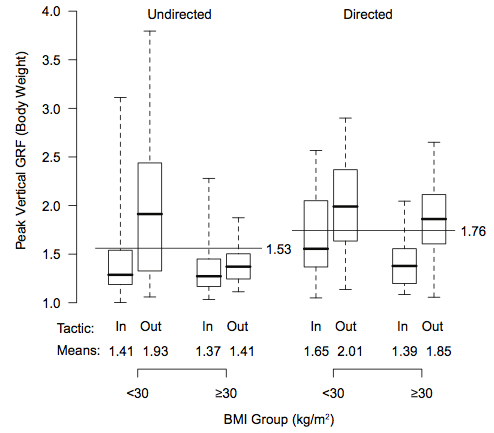Findings
Ground Reaction Forces in Egress
Reed, M.P., Hoffman, S.G., and Ebert-Hamilton, S.M. (2010). The influence of heavy truck egress tactics on ground reaction force. Proceedings of the 2010 International Conference on Fall Prevention and Protection. National Institute for Occupational Safety and Health, Morgantown, WV.
Objective: Quantify how ground reaction forces on first egress contact are affected by the tactics used to exit the truck
Method: Each driver exited the driver using a self-selected method in the first trial in each condition (undirected trials). In the second trial, the driver was instructed to perform an outward-facing egress if the first trial was inward-facing, and vice-versa (directed trials).
Results: Drivers with high BMI were significantly more likely to choose inward-facing egress tactics (X2(1) = 13.6, p < 0.001). Tactic selection was not significantly affected by step or handhold configurations.
The figure shows peak vertical ground reaction force (PVGRF) across conditions. PVGRF was significantly affected (p<0.001) by egress tactic, investigator direction, and BMI. ANOVA showed a significant three-way interaction (p<0.001) among these variables. The overall mean PVGRF was 1.64 times body weight (BW) with a large scatter across trials. The mean was higher for directed than for undirected trials, 1.76 BW vs. 1.53 BW. PVGRF was higher for outward-facing than for inward-facing egress, but the magnitude of the increase differed across BMI groups and whether the trial tactic was directed or undirected.
In the undirected trials, with drivers choosing their egress tactic, non-obese drivers (BMI < 30 kg/m2) showed much larger average increases in PVGRF than obese drivers. In the directed trials, which forced the heavier drivers who had chosen inward-facing egress to switch to outward-facing, both high and low BMI groups showed similar increases in mean PVGRF between inward- and outward-facing tactics. Overall, in undirected trials, drivers who exited facing away from the steps experienced average peak ground reaction forces of 1.75 times body weight, compared with 1.25 times for those who exited facing the steps. Averaging across all trials captures the same number of inward- and outward-facing egress events for each driver, and hence gives the best estimate of the within-subject increase in force resulting from a change in tactics (excepting missing data). Using these values, PVGRF in outward-facing egress was 28% higher (1.85 vs. 1.44 times body weight).
Required coefficient of friction (RCOF) was calculated by taking the ratio of the horizontal force to vertical force at the time of peak vertical force. RCOF was significantly affected only by tactic (p<0.001) and the effect was small. The mean RCOF was 0.085 for inward-facing and 0.07 for outward-facing egress.
Key Findings:
• Driver body mass index is strongly associated with ground reaction force after scaling for body weight.
• Obese drivers are more likely to choose inward-facing tactics than non-obese drivers.
• Drivers control the speed of their motions in a way that can offset differences in tactics and body characteristics.
• Outward-facing tactics are associated with larger ground reaction forces, except that obese drivers who choose outward-facing tactics move slowly and achieve ground reaction forces similar to those of obese individuals who choose inward-facing tactics.

©2017 University of Michigan